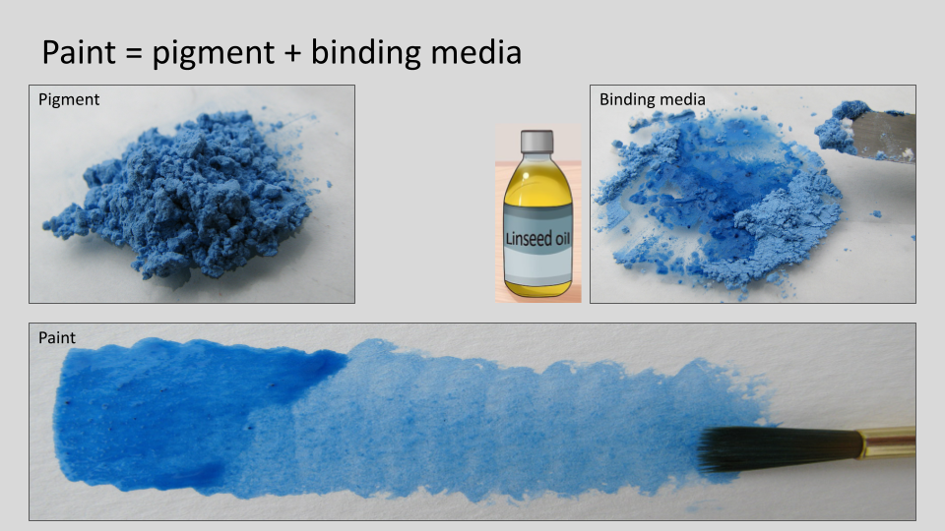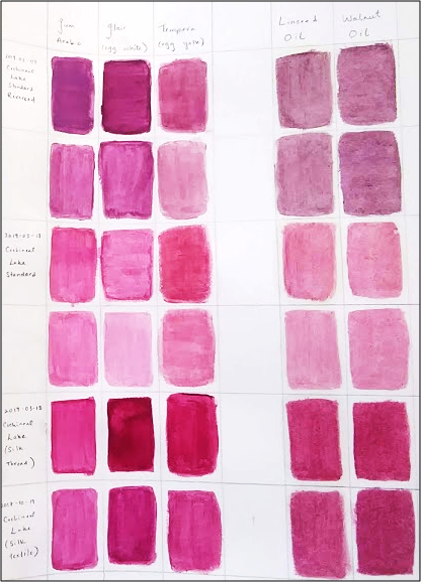Making Paints from Pigments and Painting Them Out
HIST GU4962: Making and Knowing in Early Modern Europe: Hands-On History
The Making and Knowing Project, Columbia University
Last updated 2024-07-29 by PHS
A downloadable version of this assignment: [PDF]

Paint = Pigment + Binding Media
Refer to Presentation: Introduction to Pigments & Paints

Overview of Activity
Much more detailed information and resources are provided below in this document. To help get you started, this is an overview of the hands-on work and preparation you will do:
- Create sample card on mixed media paper
- Prepare 3 aqueous binding media:
- Gum arabic (2g gum arabic + 20ml water)
- Egg yolk (tempera)
- Egg white (glair)
- Make paint with 3 pigments:
- Cochineal lake (organic)
- Azurite (mineral)
- Yellow ochre (earth)
- (or any other combination of pigments you have)
- Mull the pigments with the binding media to create a smooth, even paint (using muller and flat surface)
- Paint out your prepared paints on the sample card
- Continue experimenting with your paint!
Materials and Tools
- Gum arabic (Kremer #63330)
- Measuring cups, spoons, or food scale (to measure out water)
- Water
- 3 droppers
- 1-2 eggs
- Bowls or containers to separate eggs
- 2 paint brushes
- Plastic palette knife
- Mixed media paper (Blick, Strathmore)
- Muller (provided by M&K: an 'improvised' muller from a glass candlestick holder, Letine (amazon))
- OPTIONAL - Muller (improvised from home: try the back of a spoon, the bottom of a glass cup or jar…get creative!)
- Surface for mulling (old plate, flat plastic lid)
- Cochineal lake (historical reconstruction), prepared by you!
- Azurite (Kremer #10200, 0 - 120 µ)
- Ochre (Earth Pigments (Colonial Yellow))
Pigments
Many modern vendors now carry dry pigments so that artists can mix their own paints (following the traditional way of historical painters). Most of these pigments are synthetically made and optimized for light-fastness, consistent color, and reliable handling properties. However, there are some vendors that have worked to make available natural and/or "historical" pigments, notably Kremer Pigments (which has a beautiful store in Chelsea!), Natural Pigments, Earth Pigments, and Cornelissen & Son Artists' Colourmen.
Binding Media
Binding media for paint are typically divided into two categories: aqueous (water-based) and oil.
Oil should be kept separate from all other water-based media (eggs, gum arabic) - use separate mulling instruments, brushes, etc. and be careful about cleanup as oil is flammable, especially when soaked into paper towels.
Aqueous Media
- Watercolor and Inks - gum arabic (most common gum)
- To prepare gum arabic solution (adapted from the Columbia Ancient Ink Lab):
- 10:1 water:gum arabic by weight (e.g., 1g of powdered gum arabic dissolved in 10ml water)
- Dissolve powdered gum in water so there are no lumps.
- Stir, leave for a few minutes, stir again, push lumps of gum arabic against side of container to disperse. Repeat until there are no lumps.
- It may take a good 10 minutes (or more) for the gum to "swell" and thus fully dissolve in the water.
- To prepare gum arabic solution (adapted from the Columbia Ancient Ink Lab):
- Egg Tempera - egg yolk
- Separate the egg: break open an egg, cleanly separating the yolk from the white.
- The yolk is encased in a sack which should be removed; you want the yolk contents from inside the sack. Pierce the sack to allow the contents to flow out. Discard the empty sack.
- You may want or need to add water to thin the consistency of the yolk.
- Glair - egg white
- Separate the egg: break open an egg, cleanly separating the yolk from the white.
- Beat the egg whites into a stiff froth (historically this was done with a natural sponge; modern painters and conservators often use a blender or hand whisk).
- Let the frothed egg white sit at room temperature for several hours or overnight.
- Remove the foam on top and discard it. The liquid that remains below is glair.
Mulling Pigments
To create a smooth and "paintable" paint, the pigment particles need to be incorporated into the binding medium. Mulling pigments is the process of using a muller (typically made of glass, ceramic, or metal) atop a flat surface with a slight texture to grind the powdered pigment with the liquid binder. This allows you to disperse the pigment particles evenly within the binding medium. Some popular glass mullers for painters:
While professionals may invest in artisanal mullers and mulling surfaces (or prepare their own as described by Natural Pigments), it is easy to improvise your own mulling tools with a little creativity.
- For a muller: the non-concave bottom of a drinking glass, an espresso tamper (such as the HIC Dual-Sided Espresso Tamper), or the back of a large spoon.
- For a surface: a ceramic plate, terracotta or clay dish, stone surface, or glass cutting board. We have actually had pretty good results using the lid of an old plastic container (like those from yogurt or take-out containers)!
The Process of Mulling
- On a flat, smooth surface, place a small amount of powdered pigment.
- Add a few drops of your binding medium (using a dropper is the easiest way to prevent adding too much).
- One piece of advice on mixing pigments is to add binder in very small amounts to your pigment - you do not need much.
- Use a small spatula or palette knife to mix into a paste.
- With a muller, begin grinding the mixture in circular motions until it is smooth and has an even consistency.
- If needed, add more binding medium or water (if working with aqueous solutions), or use the palette knife to gather the paint back into the center.
- You should not need to bear down with your weight - you are combining through friction and a little force but not grinding forcefully.
Resources
Preparing your own paints (and mulling, in particular) is something that is easier shown than described in words. There are many demonstrations on the internet - search for "pigments and binders" or "mulling pigments" for videos of the process. For example, this video showing mulling with egg yolk and this video for oil and pigment.
From M&K:
- See Naomi's Flickr album on mulling and painting
- Additional helpful albums:
- Fall 2016 madder lake painting
- Google Album on mulling pigments and sample cards (note some of the grainier samples - no mulling!)
- SP19 painting out lakes in binding media
- Additional helpful albums:
Additional resources:
- Video, Jo Kirby, lecture on pigments, Met Paper Conservation in the Paper Conservation Lecture series
- Easy, Cheap, DIY, Oil Paint Muller
- Artists Materials - How Make Your Own Waterborne Paint
- Mulling Paint: A beginner-ish guide
- Hey Artists: Discover How to Make Your Own Paint
- Instructions For Making Egg Tempera
Painting Out
You have been provided with mixed media paper and paint brushes. You will first make a pigment sample card that has a spot for each type of pigment you use and each type of binder. Once you have done this, experiment!
- Different types of pigments (organic- cochineal, mineral - azurite, earth - ochre)
- Different types of binding media (gum, tempera - egg yolk, glair - egg white)
- What other types of trials can you do? Painting out a scene? Trying substrates other than paper?
Create Sample Card
| Binding medium 1 E.g., gum arabic in water (1:10) | Binding medium 2 E.g., linseed oil (Kremer #73054 cold-pressed) | Binding medium 3 E.g., Glair (egg white) | |
|---|---|---|---|
| Pigment 1 E.g., cochineal lake, prepared 2019-03-07 | |||
| Pigment 2 E.g., azurite, natural standard (Kremer #10200, 0 - 120 µ) | |||
| Pigment 3 E.g., yellow ochre (Earth Pigments, Colonial Yellow) |

Questions for Consideration
- Embodied experience:
- How does it feel to grind pigment into the different binding media using the muller?
- Are there different ratios of liquid to pigment that you need to use for each binding media to get the "right feel" of the paint?
- How do the different binding media compare?
- How does it feel to apply a gum-based paint vs. tempera (vs. glair vs. oil paint, if using)?
- Is there a difference in the way each paint wants to be handled or flows off the brush?
- What kind of movements help you apply an even layer?
- Artisanal knowledge:
- What kind of knowledge would you need in order to prepare, apply, handle, appreciate these materials?
- How might you acquire that knowledge today and historically?
- Asking new questions:
- What new questions does this experience cause you to ask about paintings or other works of art in general?
Remember to record your experiences in your field notes.
Additional Resources to Explore
- Pigment glossary in Kirby, Jo, Susie Nash and Joanna Cannon (eds.), Trade in Artists’ Materials: Markets and Commerce in Europe to 1700 (London, 2010)
- Technical Art History Website, University of Delaware
- CAMEO: Conservation & Art Materials Encyclopedia Online (explore, and check "Materials database")
- The Fitzwilliam Museum: Overview of Artists' Materials - ILLUMINATED
- Yale University Traveling Scriptorium - A Teaching Kit by the Yale University Library
Practical painting resources from Natural Pigments
- Artists Materials - How Make Your Own Water-based Paint
- Artists Materials - How to Make Your Own Oil Paint
Remember to record your experiences in your field notes.
A downloadable version of this assignment: [PDF]